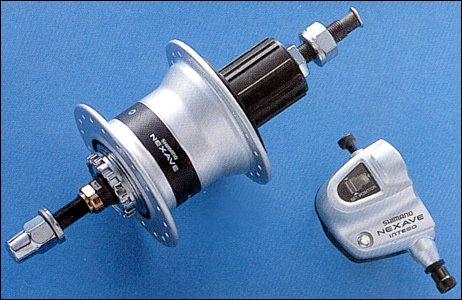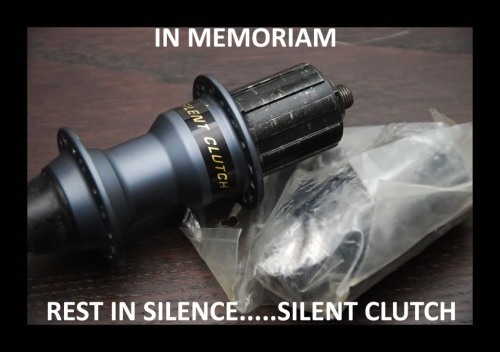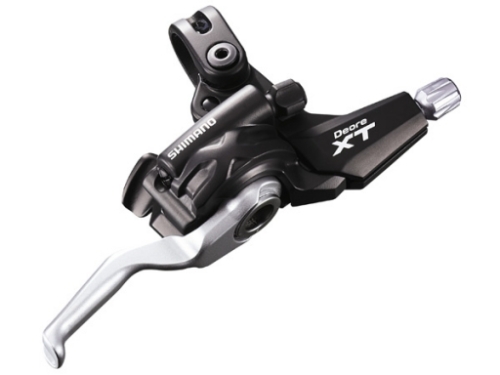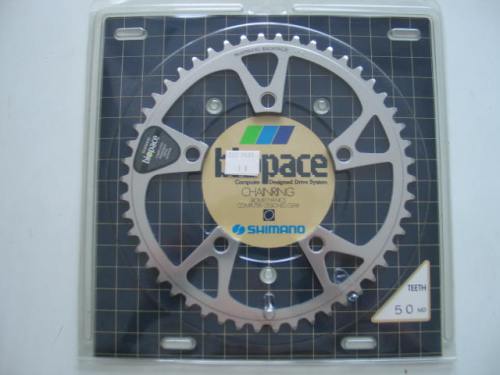Lately I’ve been gathering information about Shimano trademarks, inventions and products. I found out interesting writing down a long article to explain those technologies that did not succeed and finally faded into oblivion.
Again I have to thank Sheldon Brown for his articles. I did some copy&paste to explain those parts I never dealed with in the flesh. I also checked some internet bike boards and did the same when it was strictly necessary :mrgreen:.
You will be amazed how some of the solutions adopted work and their gadgety and funny design.
They all share something: they vanished off the face of the earth for uncertain reasons and no longer available, they are all Shimano genuine trademarks with no plagiarism, there is a lot of controversy if they were any good, and they will make you think “why the fuck I’ve never heard about the majority of them” 😀 .
10 . Dyna Drive ®
In the early 80’s, Shimano introduced a special crank/pedal set, which used much larger diameter threading where the pedal screwed into the crank. This allowed them to build the bearing into the inside of the pedal thread, eliminating the need for a pedal axle. The purpose of this was to improve the ergonomics of the pedal by placing the bottom of the foot below the pedal axis.
A good idea biomechanically, but never caught on. In practice, the pedal bearings turned out to be underengineered for the loads they had to deal with.

Designed to lower the rider’s center of gravity and improve aerodynamic too. You can get spindle adapters to run standard 9/16″ pedal spindles
9. Front Freewheel System ®
The Shimano Front Freewheel System (FFS) was a proprietary drivetrain seen for the first time in 1977 that placed a freewheel between the pedal cranks and the front chainrings.
The “freewheeling” mechanism is built into the crankset bottom bracket, but for safety reasons, the rear cogs are not just fixed to the wheel. The rear freewheel had higher friction than the front so that the spinning of the wheel will drive the freewheel and chain when coasting enabling the rider to shift gears with no pedal strokes. In fact, walking the bicycle drove the rear wheel and chain, allowing shifting if you had left the bicycle in too high a gear. You simply had to push the bicycle forward and move the lever to select the desired gear.
If an object, such as a pants cuff, gets caught in the chain, the rear freewheel engages. This overrides the FF mechanism and the chain stops moving.
The resulting system proved good reliability. The major problem was that local bike shop salespeople did not take the time to learn the system and what it could do for novice cyclists. Besides it was heavier and more complex than a standard freewheel, we can conclude that offered features that no one really needed and, in any event, did not penetrate the market noticeably. Sheldon Brown called FFS “a solution in search of a problem”.

FFS marketing followed Shimano’s path of beginning with lower-cost implementations of the system using low tech and usually heavier materials
8. Interactive Glide ®
The IG abbreviation for Shimano Interactive Glide gear system is an extension of the Hyperglide concept, in which both sides of the bicycle gear sprockets are physically contoured and ramped on the face of a cog to improve upshifting.
Interactive Glide sprockets are slightly thicker than Hyperglide ones in order to mantain the full thickness of the teeth, and as a result, HG chains may hang up if used on an IG cassette. IG chains will work on HG cogs though. Since the sprockets are thicker, the spacers must be thinner to have the correct spacing on 7 and 8 speed systems. However, IG chains are narrower, 7.1mm vs 7.4mm for the HG versions.
Shimano said that you shouldn’t mix IG and non-IG sprockets, but if you use one IG spacer per IG sprocket, you should be all right.
IG was released in 1995 in the mid-range, between STX-RC and Alivio drivetrain parts. Apart from some XT chainwheels, it never reached the more refined gruppos. It disappeared in short time because of the higher prices and, given the good shifting quality of the HG chainsets, goodness knows what the new features were trying to improve upon.
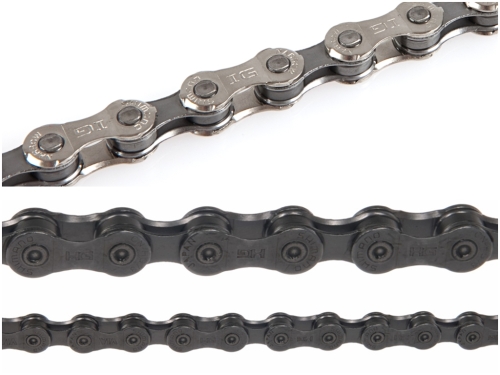
HG chain has bowed-out outer link plates (bottom). IG chain (top) has nicks out opposing corners of each outer plate to facilitate outward shifting
7. Intego ®
Shimano has a long tradition (and a worthy chunk of its cycling business) around internal gear hubs. But failed caming out with the Intego hub as it had already other well stablished models and the fierce competence of the better SRAM Dual Drive, which was all poshed up from the previous Sachs 3×7.
The Shimano outcome was not a bad idea. As others competitors did, the japaneses pretended to revitalise the city bike market with a hybrid hub that could do the transition between conventional derailleurs towards geared hubs, providing the same wide gear ratio.
The design mixes a 3 speed internal gear hub with a freehub so that it eliminates the hassle of a front mech (the one that works worse) whenever an 8-9 or even 10 speed cassette is installed on it.
6. Positron ®
The PPS System was Shimano’s first attempt at indexed shifting. The “clicks” were built into the derailleur, not the lever. Unlike conventional drivetrains, the system didn’t have a return spring; some models used a double cable to pull the mech back and forth, other models used a single, semi-rigid push-pull cable.
Positron was a valuable learning experience for Shimano. In 1982, the theory was that experienced cyclists already knew how to shift, but beginners could benefit from a system that didn’t require fine-tuning of the shift lever position. For this reason, Positron was offered on entry-level bikes. This marketing theory turned out to be unworkable. The parts had to be made very cheaply to meet the price points required. This caused a less-than-impressive performance. In addition, the fact that Positron was only supplied on bottom-end bikes caused it to acquire a poor connontation, as something to be outgrown, and not to be considered by “serious cyclists”.
Shimano went back to the drawing board, and the next time they tried indexed shifting, in 1984, they started at the top of the line, with Dura-Ace S.I.S. The result was that by 1986 it had become almost impossible to sell a bike that didn’t have indexed shifting.
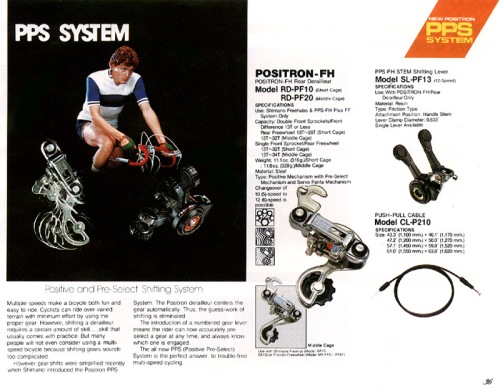
Many Positron-equipped bikes also featured the Front Freewheel System®, but this was not a specific linkage. Either of these systems could and did function without the other
5. Airlines ®
Truth been said: I don´t know much about downhill. But I still remember the day, when a forum member registered on an internet board awoke my interest for a while in some information regarding a supernatural old project of creating an air-powered derailleur shifting system that Shimano upfronted between 1996 and 1999.
At first sight it seems a seedy configuration -quite the contrary- it was developed based on input provided by professional racers riding prototypes in competitions.
The advantage of Airlines pneumatic shifting action is that allows the off-road to shift gears instantaneously with a minimum effort and lag.
You can find plenty of information and pictures in the original publicity leaflet: specs, the team in charge of the developement, a very limited production, hand assembled parts in a special Shimano facility…
The development has all the ingredients of those top-notch creations that never pay off but show the power of a company. An abandoned idea because of the costs of production and constant refills of compressed air.

The tank and air regulator are the most distinctive components in the system that also includes shifters and a special 7 sprocket cassette with 9 speed spacing
4. Silent Clutch ®
The Silent Clutch in Shimano’s terminology is a type of freewheel ratchet mechanism which uses cams and rollers instead of pawls. The patent goes back to 1996.
In addition to eliminating the noisy “tick-tick-tick” of a pawl-type freewheel, a roller clutch has less slop when drive force is applied to it. Drive begins as soon as forward motion of the pedals starts, unlike a pawl-type freewheel which only drives once it has rotated far enough to let the pawls engage the notches of the ratchet ring.
The technology has been used notably in the Shimano Nexus and Alfine series but discarded in the Freehub types.
3. Rapid Rise ®
In 1998, a new rear mech known as Low-Normal in Shimano’s slang came to life. Both beloved and hated by the mountain bike community, Rapid Rise were discontinued a decade after with the advent of the Shadow type that does not play well together with inverted parallelograms.
The idea behind is that it’s easier to rapidly shift to an easier gear when you suddenly face an uphill struggle.
Rapid Rise resting position works the opposite way as the spring retracted is in the lowest, easiest (biggest cog) gear. Hence ‘Low-Normal’. When you release all the tension, the chain goes to the easiest/largest cog.
You have to use your thumb lever to pull the spring and shift to a higher (more difficult, smaller cog) gear, and your forefinger to release the tension and let it jump to a lower gear (though this lever flick both ways these days, so you can use thumb as well).
After few years of scepticism, Rapid Rise mechs underwent a revival when they were frequently matched with Dual Control levers until they finally took the same bus out of Shimano town.
I suspect that these mechs just had too small sales volume to keep going with them as they seemed to rub a lot of people the wrong way.
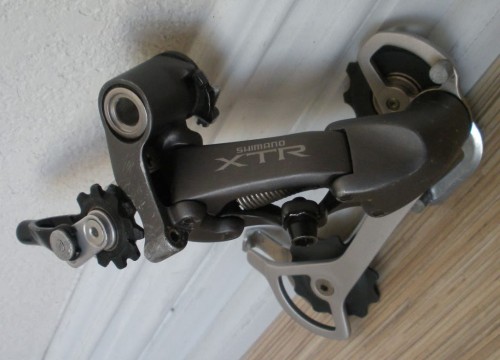
XTR RD M951 Rapid Rise weirdness was released in 1998 when MTB 8 speed generation was still alive, but discarded a year after for the model M953 (9 spd) that did not include that distinctive pulley to avoid sharp radii and excess of housings and thus reducing friction. Shimano stated an improve of 10% in smoothness
2. Dual Control ®
This is the case of one of the most notorious fails in Shimano’s history.
Dual Control (DC) levers were introduced in 2003 to mountain bikes, letting you switch gears with the brake handle thanks to a shifter that was integrated into the brake.
The development was controversial as the use of DC integrated shifting for hydraulic disc brakes required using also Shimano hydraulic brakes, locking competitors out of the premium end of the market. However, with their 2007 XTR second generation DC product line, Shimano moved back to make separate braking and shifting components fully available in addition to the integrated “Dual Control” components. A move to satisfy riders that wished to use Shimano shifting with other brands of disc brakes.
These components found their own niche, like Rapid Rise mechs did, but then again, bummer acceptance rate ended up with Shimano ditching a functional design by the time the generation of 10 speed MTB systems were unveiled.
The main advantage of DC is that a rider can go down the hill into rock/root and shift at the same time of braking.
1. Biopace ®
Biopace is Shimano’s tradename for a type of ovoid chainring produced from 1983 to 1993.
Non-round chainwheels are designed to provide varying mechanical advantage, changing the gear ratio at different angles of crank rotation with the intention to be more ergonomic by helping to overcome the “dead pedal stroke zone” where the crank arms are vertical and riders have little mechanical advantage.
Biopace chainrings do almost exactly the opposite to the intention of most oval style chainrings, where at top and bottom dead centre (BDC) the effective diameter of the chainring is small, having Biopace the reduced chainring diameter coinciding with the cranks being horizontal.
It is now easier for the rider to turn through BDC allowing the legs to carry a lot of momentum through the power stroke.
By having the chainring at its peak effective diameter with the cranks leveled, that is, where the rider has maximum leverage over the crank during the power stroke, better use of the speed of the legs can be made to increase power output.
The reason this is beneficial is that it tends to smooth the pedalling action but encouraging riders at the same time, to push bigger gears and risk knee damage due to higher knee joint loadings.
In those days, a minority of cyclists found their benefits worthwhile (including Sheldon Brown), but most of them occasional cyclists. Rare usage in pro-bikes and the difficult bio-dynamics involved did not prove the advantages of non-circular versus circular forcing shimano to discontinue the Biopace era.
It is still very controversial, but all we guess when comparing Biopace to most modern oval chainrings is that Shimano went with the wrong concept, assuming non-circular chainrings may improve pedal dynamics by reducing the effect of the “dead spot” in the pedaling cycle rather than thinking on elliptical rings to be more efficient through matching the torque output capability of humans to the torque input requirement of the pedaling cycle.

